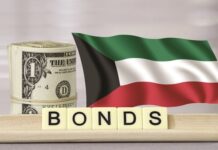The US agency ‘Standard & Poor’s’ announced that Kuwait’s sovereign credit rating will remain at (A+) with a negative outlook, expecting the real GDP to grow by 8% this year, driven by the increase in oil production under the “OPEC +” agreement.
The agency expected, in its report on Kuwait’s sovereign rating issued yesterday, Friday on its website, that the average budget deficit in Kuwait will reach 12 percent of GDP until 2025, despite the high prices and quantities of oil production which is among the highest rates among all countries classified by the agency, reports Al-Rai daily
The agency stated, “the government is about to exhaust the General Reserve Fund liquidity but has yet to reach an agreement with the Parliament members on a comprehensive strategy for financing the budget deficit, which represents financing risks for the state, especially if oil prices drop.”
The agency pointed out that relations between the executive and legislative authorities are beginning to improve after the national dialogue, which increases the possibility of passing the Public Debt Law and the Public Financial Consolidation Plan, noting that the negative view of the classification reflects the risks over the next 12-24 months related to the government’s ability to overcome the crisis, institutional obstacles that prevent it from implementing a strategy to finance the budget deficit in future.
However, there is possibility of downgrading Kuwait’s credit rating if the high budget deficit persists in the med-term in the absence of comprehensive, sustainable and agreed financing arrangements on public debt or authorizing other sources to finance the deficit.
The agency indicated the possibility of changing the rating outlook to stable if the government succeeds in addressing the current restrictions on financing the public budget by approving the public debt law and authorizing the government to benefit from the Future Generations Reserve Fund and the Public Financial Control Program.
The agency pointed out that Kuwait is currently benefiting from the rise in oil prices from its lowest levels since the beginning of the pandemic in 2020, and it is expected that Kuwait will nevertheless face a public budget deficit averaging 12 percent of GDP in the medium term, and the equilibrium price of the public budget is estimated between 85 and 90 dollars a barrel.
Regarding the positive developments after the national dialogue, the agency said these conciliatory moves increase the likelihood that the government and parliament reaching an agreement on major structural reforms, noting that a comprehensive strategy for financing the budget has not yet been developed, while the General Reserve Fund has been exhausted, and “this situation constitutes financing risks and negative credit rating especially if oil prices drop.
It estimated the total general government debt of Kuwait at 8 percent of GDP, while interest expenditures amount to about 1 percent of total public spending, indicating that any possible adjustment to uncontrolled public spending could weaken the economy and weaken the confidence of foreign investors.
The sources pointed out that Kuwait is the only Gulf country that has not yet implemented the value-added tax at a time when reducing public spending is politically difficult, given that most of it represents government wages and subsidies.
The agency stated that Kuwait’s economy is largely dependent on oil, as it accounts for about 90 percent of government exports and revenues, and the oil sector constitutes 50 percent of GDP, expecting that economic performance will strengthen over the next two years after the difficult period of the pandemic.
It is also expected that the gross domestic product of Kuwait would reach slightly less than about 140 billion dollars in 2024, which is an almost constant level compared to the levels of 2018, indicating that the total assets of the sovereign wealth fund exceed 460 percent of the GDP and the general government net assets are estimated at about 450 percent of GDP, the highest among all sovereign bodies.
The sources say the general budget deficit is the highest in the world with the absence of a comprehensive financing strategy, expecting that the Kuwaiti dinar will remain linked to a basket of currencies dominated by the US dollar, which is a system that served Kuwait in a way “however, it restricts its ability to manage an independent monetary policy to help mitigate fluctuations in the cycle.” In addition, the local currency debt market is less developed compared to its peers.
The agency says the measures taken by Kuwait during the past two years to address the financial situation are much less than what is required to bridge the financing gap, including measures related to annual financial transfers to the Future Generations Reserve Fund and injecting additional liquidity to the General Reserve Fund by transferring some less liquid assets to the ‘Reserve Fund’.
The sources said the classification reflects the strong conditions of government assets and the balance of payments, expecting that the net external credit position of Kuwait will have reached 480 percent of GDP at the end of last year, and that the current account of the balance of payments will record a surplus of about 17 percent of GDP, supported by prices and quantities of oil production and income from foreign investments managed by the Kuwait Investment Authority.
The sources emphasized that the Kuwaiti banking sector has entered the economic downturn phase in a relatively strong position, as the Central Bank of Kuwait immediately moved to implement several support measures for the economy and the financial system.

















